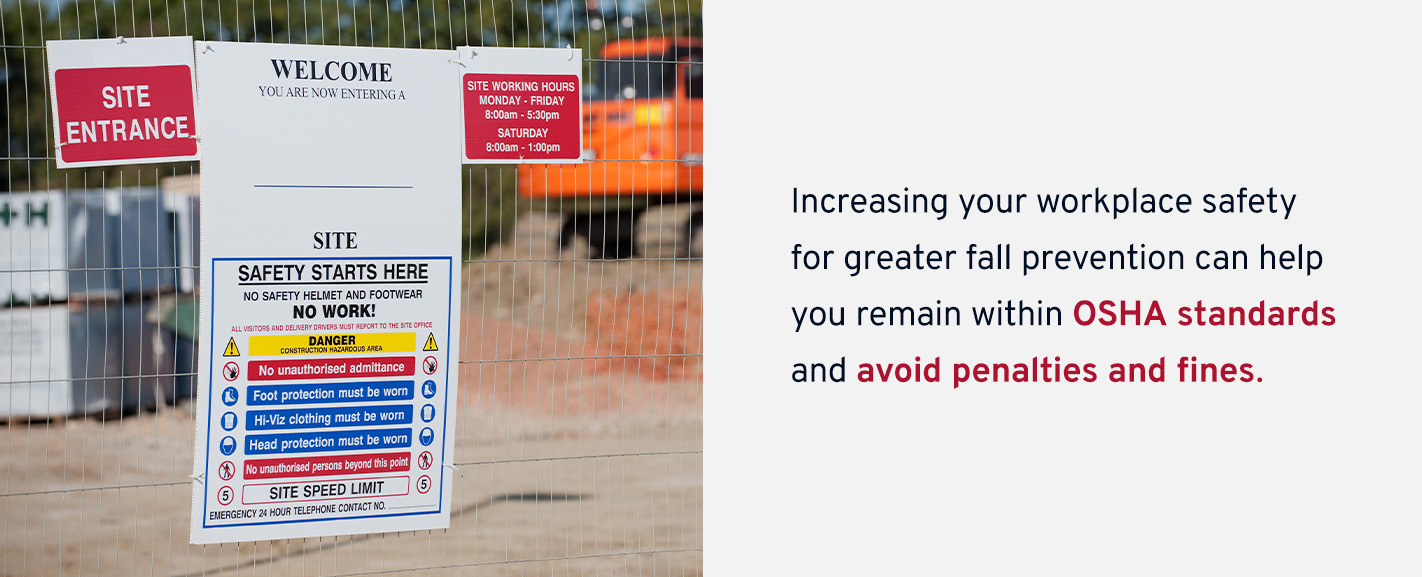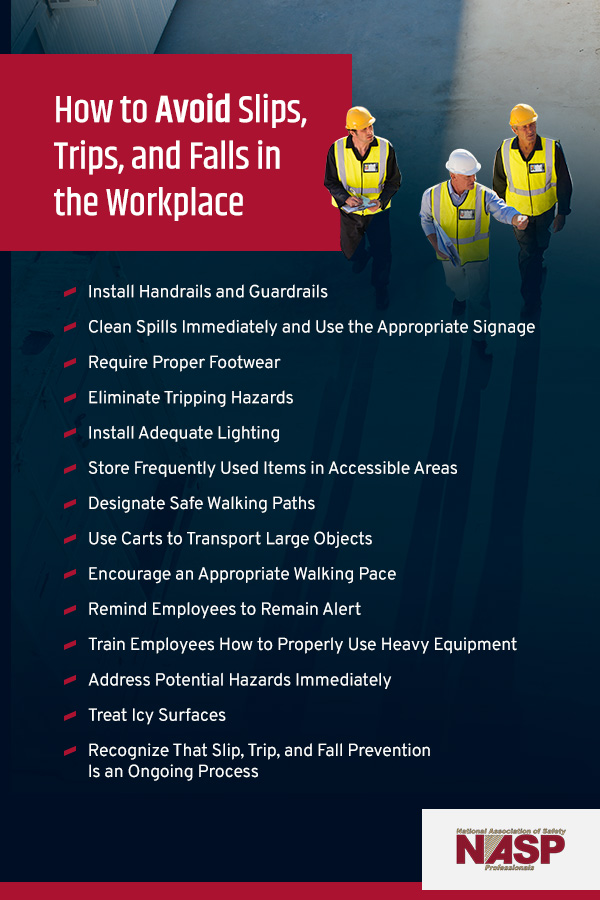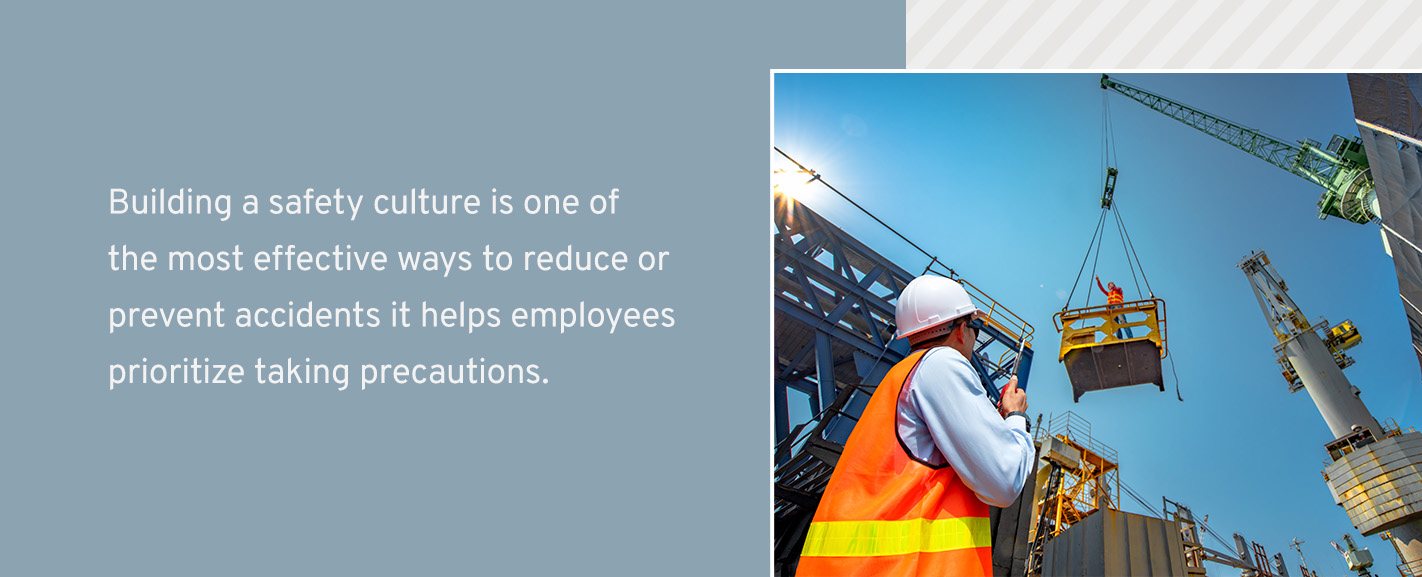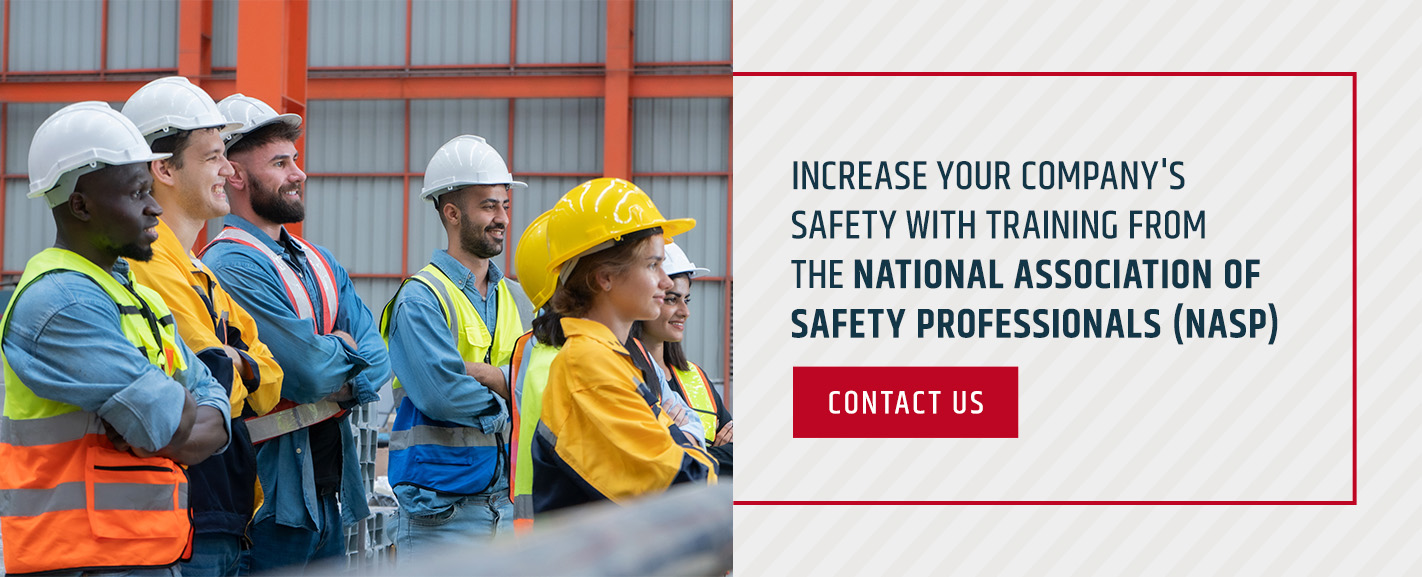
A workplace slip and fall can result in serious injury, so prioritizing preventative measures is essential. When you implement effective safety plans, train employees, enforce policies, and maintain walking and working surfaces, you can prevent or reduce workplace accidents. Creating a safer work environment and building a safety culture in your company are the best ways to protect your employees in any work environment.
Importance of Slip, Trip, and Fall Safety
Slips, trips, and fall prevention is essential on any job site, but it’s especially crucial in industries that involve heavy machinery, high shelving, or a high likelihood of wet floors. Focusing on fall safety offers the following benefits:
Employee Safety, Morale, and Retention
Prioritizing employee safety helps protect individuals from harm and can boost morale. The more measures you take to protect your employees, the more likely your employees are to trust you and want to stay with the company.
Cost Savings
Implementing an effective safety plan that prevents falls can help your company save money. Most companies must pay workers’ compensation if an employee is injured on the job. While this protects companies from direct lawsuits, it can also result in high costs as employers cover medical coverage for injured employees. In 2022, workplace injuries cost companies a total of $167 billion. Taking steps to prevent falls may help your company reduce workers’ compensation claims and save money.
Productivity and Efficiency
Preventing slips, trips, and falls can also boost your company’s productivity and efficiency. When fewer employees experience accidents and injuries, you have more individuals able to work. A fall can result in a serious injury depending on how a person falls and what part of their body they land on, and this can potentially cause a worker to be in the hospital or at home for a prolonged time.
Preventing falls can help you keep more employees safe, at work, and able to produce quality results, helping you meet productivity and efficiency goals.
Compliance

The Occupational Safety and Health Administration (OSHA) enforces regulations regarding walking and working surfaces. Increasing your workplace safety for greater fall prevention can help you remain within OSHA standards and avoid penalties and fines.
Primary Causes of Slips, Trips, and Falls in Work Settings
To fully understand how to prevent slips, trips, and falls on the job site, you must first understand what causes them. Consider how each of the following accidents can occur:
Trips
Trips occur when individuals lose balance due to their foot hitting or striking an object. An employee may trip due to one of the following factors:
- Clutter or obstructions such as power cords, hoses, boxes, or tools on the floor or ground
- Inadequate lighting
- Irregular or uneven walking surfaces
- Curled-up or wrinkled rugs
- Rugs with lifted edges
- Inattention to surroundings
- Running or walking too fast
Tripping occurs when an employee moves with enough momentum to lose balance. Paying attention to their surroundings and walking at a slow pace are the most important ways to prevent trips.
Slips
Slips occur due to a lack of traction or friction between walking surfaces and footwear. The following factors can cause an employee to slip while working:
- Oily or wet surfaces
- Liquid spills
- Dry products such as dust or powder on the floor
- Weather hazards such as rain puddles, snow, or ice
- Loose mats or rugs
- Running or walking too fast
- Greasy, muddy, or wet shoes
Falls
Slips and trips are common causes of falls, but the following factors can also cause an employee to lose balance and fall:
- Obstructed views from walking while carrying large objects or turning a corner too fast
- Inattention to surroundings
- The use of inappropriate equipment such as tables, chairs, or carts to reach high areas
- Using ladders or other equipment incorrectly
- Elevated platforms or surfaces lacking guardrails
How to Avoid Slips, Trips, and Falls in the Workplace

You can help employees avoid or reduce slips, trips, and falls with the following tips and safety precautions:
Install Handrails and Guardrails
Handrails provide support for employees walking up or down a staircase. Ensure each set of stairs inside and outside your building has handrails so employees and patrons can remain steady while walking.
Guardrail installation is also essential. If your facility contains any type of elevated platform or surface, you must install guardrails to prevent employees from falling.
Clean Spills Immediately and Use the Appropriate Signage
Spills present a significant slipping hazard, so you should clean them immediately after they occur. Remind employees to avoid leaving spills unattended and instead ask a colleague to gather cleaning supplies. It’s also important to place “wet floor” signs in the affected area until the floor is completely clean and dry, and this applies to any time you mop the floor. These actions prevent employees from walking through the spill unknowingly.
Signage is also helpful when your facility has freshly waxed floors. Waxing a floor makes its surface slippery, so it’s important to let employees know when they should walk with extra caution.
Require Proper Footwear
Proper footwear provides the traction employees need to walk on wet and slippery surfaces safely. Most companies aiming to prevent falls require individuals to wear skid-resistant shoes with soft rubber soles because they grip wet surfaces better than other types of shoes. The right shoes can significantly increase an employee’s likelihood of avoiding slips in the workplace.
Help employees obtain proper footwear by recommending quality brands and where to purchase them. You can also let your employees know if your company offers financial support for shoe purchases through reimbursement programs. Another way to ensure employees wear proper footwear is to work it into your employee handbook and enforce it as a safety policy.
Eliminate Tripping Hazards
The more tripping hazards you remove from a work area, the easier it is to prevent falls. Frequently remind employees to keep walkways, stairways, and doors free of objects. This may mean keeping tools up and off of the floor or ensuring extension cords are out of the way. If you must run an extension cord across a walkway, secure it in place with brightly colored tape so employees can see it easily.
Another tripping hazard is open cabinet doors and desk drawers. Remind employees to keep these storage spaces closed when they are not in use to prevent individuals from walking into them and tripping.
Install Adequate Lighting
Well-lit areas help employees see potential tripping hazards and slippery surfaces easier than they would in dimly lit areas. Ensure each area in your facility has adequate lighting to increase visibility and replace lightbulbs when necessary. The best way to increase visibility is to install motion-sensor lights because they provide adequate lighting while conserving energy.
Store Frequently Used Items in Accessible Areas
Making items easily accessible can help reduce foot traffic and accidents in your facility. For example, placing the right cooking tools directly in a chef’s workstation reduces the amount of time they need to walk across the kitchen. Similarly, storing materials in an easily accessible area within a warehouse reduces the number of times employees need to reach for items on high shelves.
Designate Safe Walking Paths
Designating safe walking paths and clearly marking them can help employees avoid hazardous areas. This is especially true in warehouses where many areas are prone to tripping hazards. Place yellow tape on the floor to mark safe walking paths, and remind workers to keep these paths clear of objects such as tools and cords.
Use Carts to Transport Large Objects
Walking with or pushing large objects across a room can cause an employee to collide with another person or trip over an obstacle. Provide employees with carts they can use to transport large items through your building or across a job site.
Encourage an Appropriate Walking Pace
Walking at a slow pace helps people avoid trips, slips, and falls because it gives them more time to notice obstacles or catch their balance. Create a “no running” policy for employees and encourage everyone to move at a slow pace.
Remind Employees to Remain Alert
Alertness and awareness are essential for preventing falls and accidents. In your safety training, remind employees to remain aware of their surroundings by avoiding reading, texting, or scrolling while walking.
Train Employees How to Properly Use Heavy Equipment
Part of using heavy equipment safely is proper entrance and exit. Train employees how to get into and out of heavy machines such as forklifts to reduce the chances of them falling from the equipment.
Address Potential Hazards Immediately
As a safety professional, you are responsible for monitoring your company’s facility, employees, and operations. It’s your job to recognize potential hazards and address them as soon as possible.
Treat Icy Surfaces
If your company is in a cold climate, snow and ice are possibilities. Ensure the walkways into your facility are clear by applying ice melt each time winter weather hits. Ice melt prevents wet surfaces from freezing, and it can dissolve icy surfaces. This makes it easier and safer for employees to enter and leave the building without slipping.
Recognize That Slip, Trip, and Fall Prevention Is an Ongoing Process
The circumstances that cause falls in the workplace can be changeable and spontaneous, so it’s essential to remember that prevention is an ongoing process. You must check surfaces frequently, address hazards promptly, and ensure employees understand how to recognize hazards and avoid them.
Regulations Regarding Walking and Working Surfaces
OSHA standard 1910.22 outlines regulations companies must follow regarding walking and working surfaces. Following these regulations helps you remain compliant and can make it easier to prevent slips, trips, and falls:
Surface Conditions
All walking and working surfaces must be clean and sanitary. When compliance safety and health officers perform inspections, they check service rooms, storerooms, and passageways to determine if surfaces are clean and orderly. Additionally, floors must be clean, dry, and free of the following hazards:
- Protruding or sharp objects
- Corrosion
- Loose boards
- Spills
- Leaks
- Grease buildup
- Ice and snow
If your company uses wet processes, you must have a proper drainage system in place and maintain it regularly. OSHA also requires companies that use wet processes to provide dry standing places, such as platforms, mats, and false floors.
Floor Loads
OSHA requires companies to ensure their walking and working surfaces are able to support their intended loads. For example, employees must limit heavy machinery use to floors that can handle the equipment’s weight. This prevents machinery from causing accidents or damaging floors and creating tripping hazards.
Access and Egress
Safely walking to and from walking and working surfaces helps prevent falls. To comply with OSHA standards, your company must provide safe ways for employees to safely access and egress walking surfaces, and you must enforce safety policies to ensure employees use the provided means. For example, you may install ramps or platforms to access walkways, or you may place tape on the ground to indicate safe walking paths.
Maintenance, Inspection, and Repair
OSHA also requires companies to regularly inspect and maintain walking and working surfaces, completing repairs as necessary. If damage or wear occurs on one of your company’s floors, you must repair it before employees use the floor again.
If you cannot make immediate repairs, OSHA requires you to guard the hazard and redirect employees to use alternative safe walking paths. Additionally, you must hire a qualified professional to perform or supervise repairs if they involve the walking surface’s structural integrity.
How to Train Employees on Preventing Slips, Trips, and Falls

Building a safety culture is one of the most effective ways to reduce or prevent accidents because it helps employees prioritize taking precautions. While there is no required training for fall prevention, you can provide helpful information and help employees avoid unsafe situations and conditions. Use the following tips to help your employees implement safer walking practices:
- Discuss injuries: Explain to your employees that slips, trips, and falls can lead to significant injuries such as broken bones, fractures, concussions, neck injuries, deep bruising, cuts, spinal cord injuries, and fatalities. Individuals are more likely to take fall prevention seriously when they are aware of potential consequences.
- Review OSHA Standard 1910.22: Reviewing OSHA standards with employees can help them understand how policies and procedures protect them from potential injuries. Use this opportunity to explain to workers what their roles are in preventing accidents.
- Review safety precautions: Review additional ways employees can protect themselves such as walking at slow paces, wearing the proper footwear, and remaining alert.
- Point out hazardous areas: Give new employees a tour, and show them areas in your facility that may present additional fall risks. These areas may include rooms with frequent spills, such as kitchens, or heavy-traffic areas, such as warehouses.
Increase Your Company’s Safety With Training From The National Association of Safety Professionals (NASP)
Preventing slips, trips, and falls is an ongoing process that requires a safety mindset. The National Association of Safety Professionals offers a practical approach to workplace safety, providing in-depth training programs. Our certificate courses provide the information and knowledge safety professionals need to implement successful safety plans, address potential hazards, reduce workplace accidents, and comply with OSHA standards.
At NASP, we design courses to increase student retention and keep safety at the forefront of everyone’s mind. Our goal is to help your company build a safety culture that extends beyond meeting regulations, and we are dedicated to helping safety professionals expand their expertise. Browse our online professional courses and live safety training classes, or contact us to learn more about how we can help you enhance your company’s safety.






